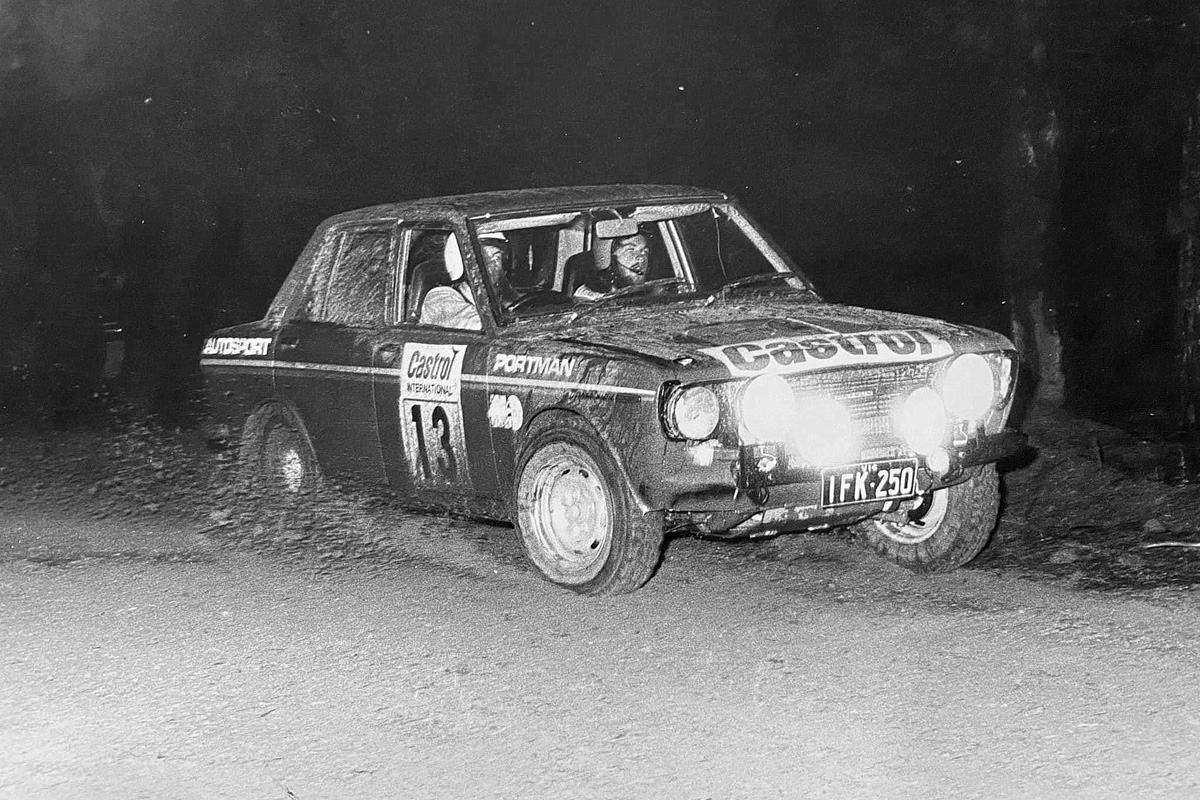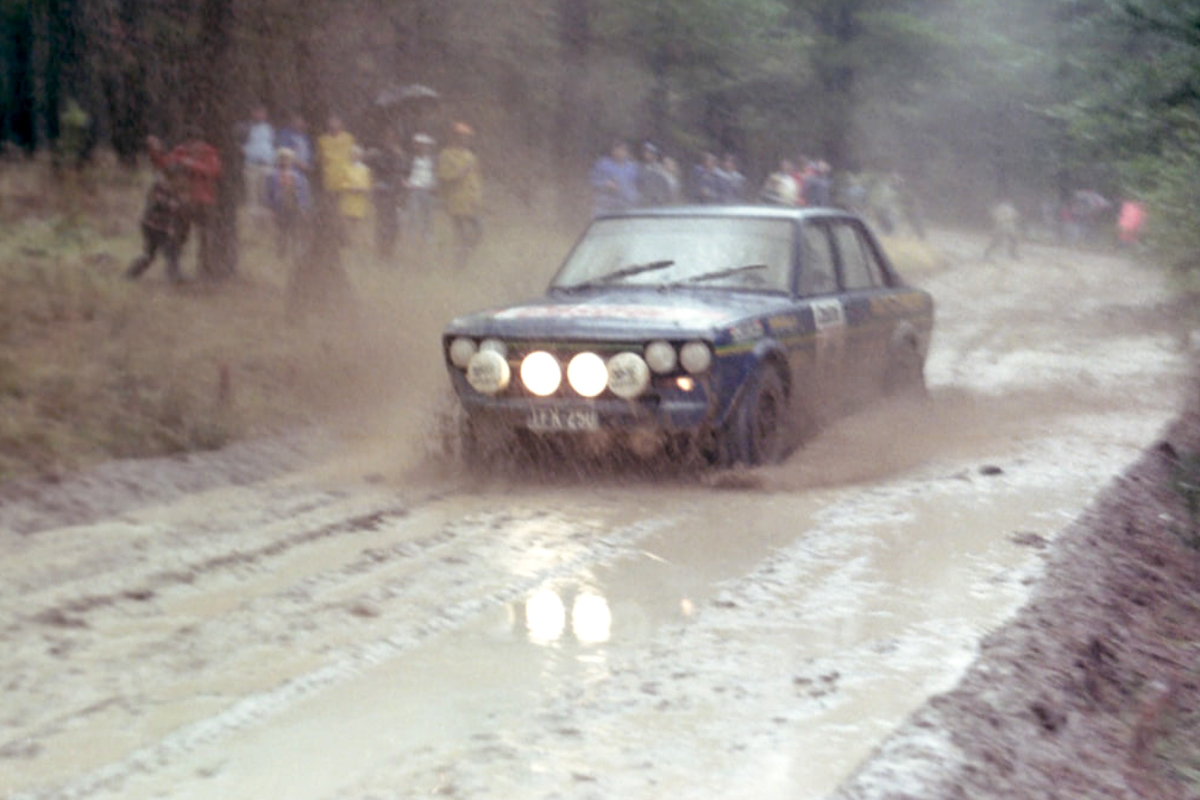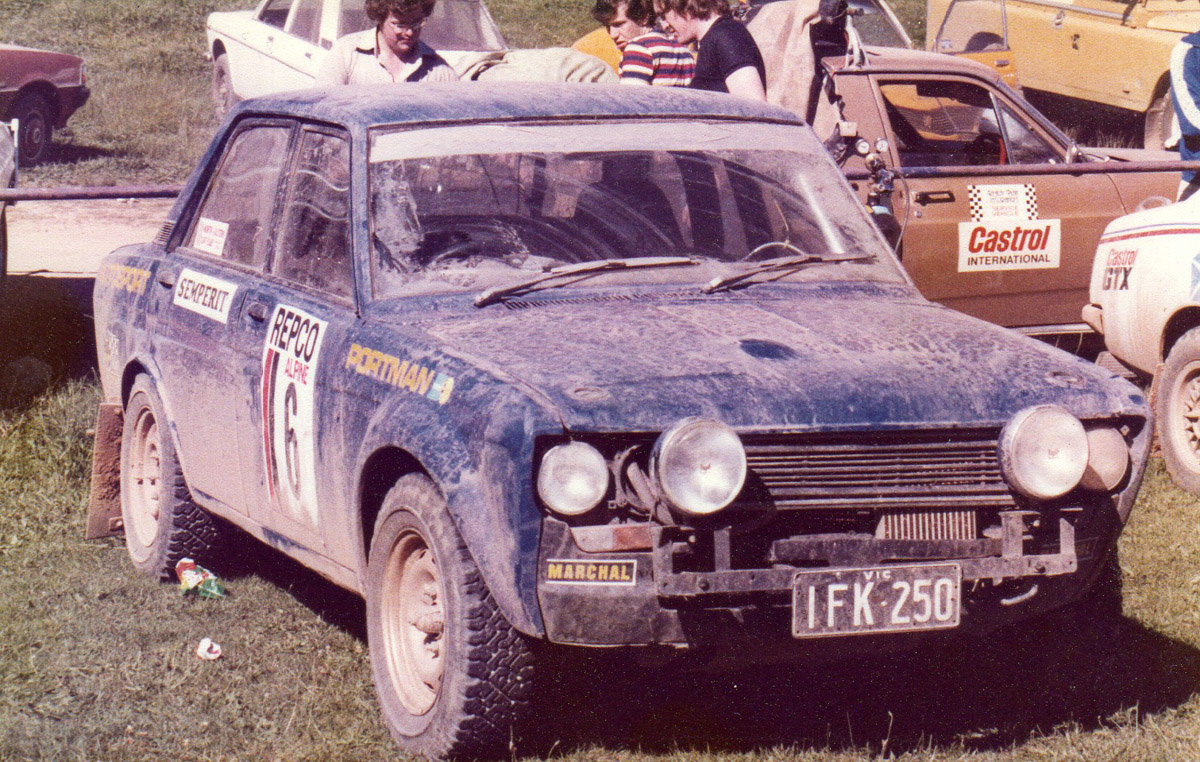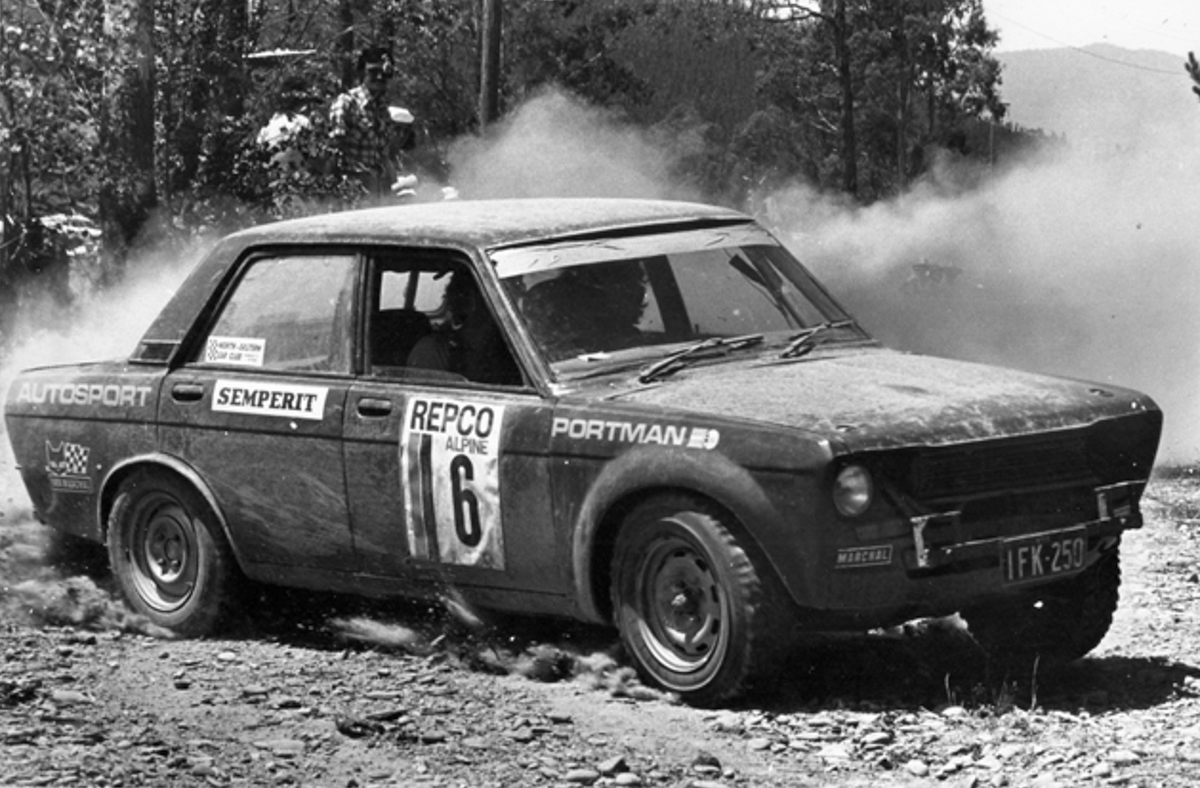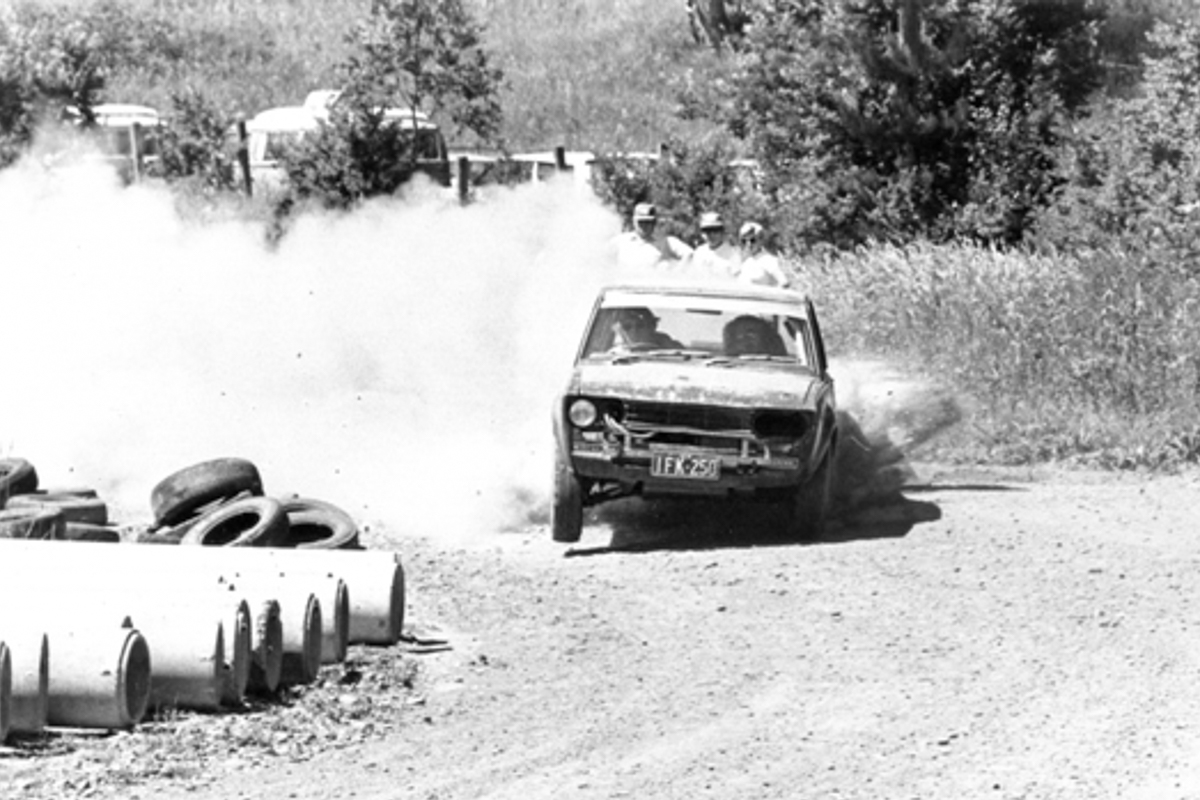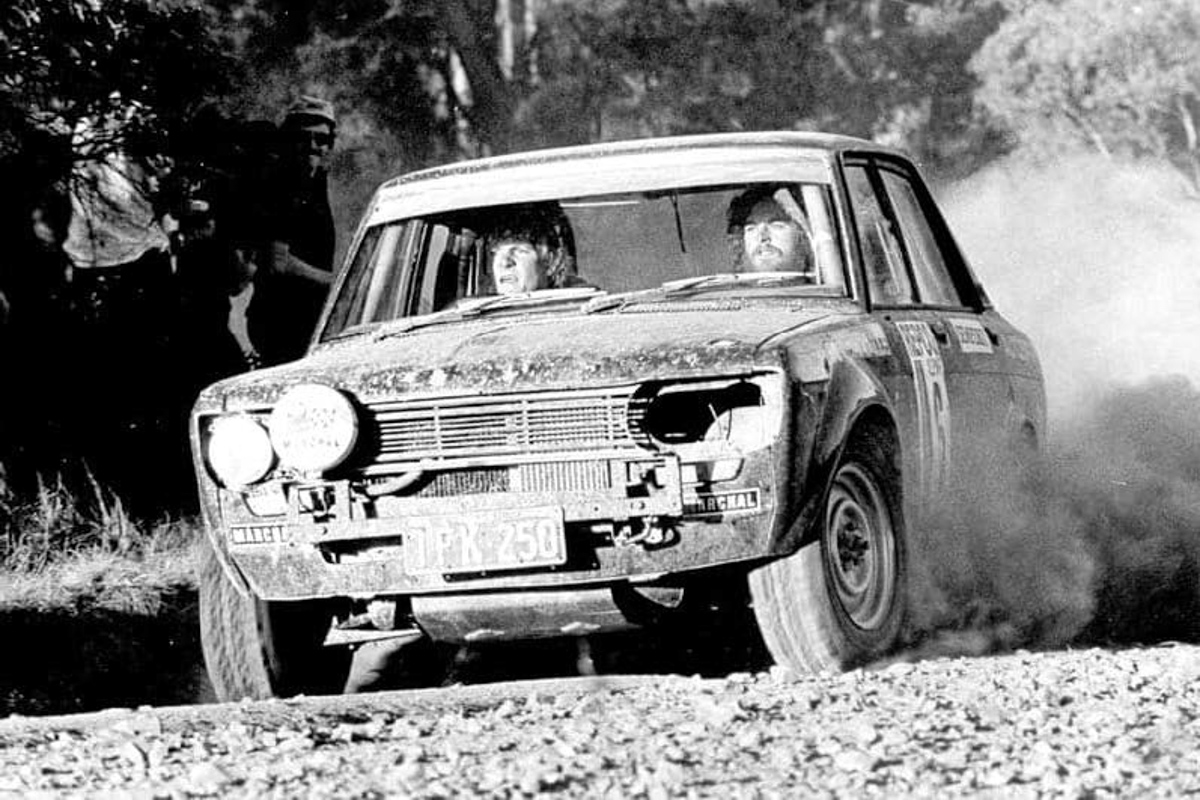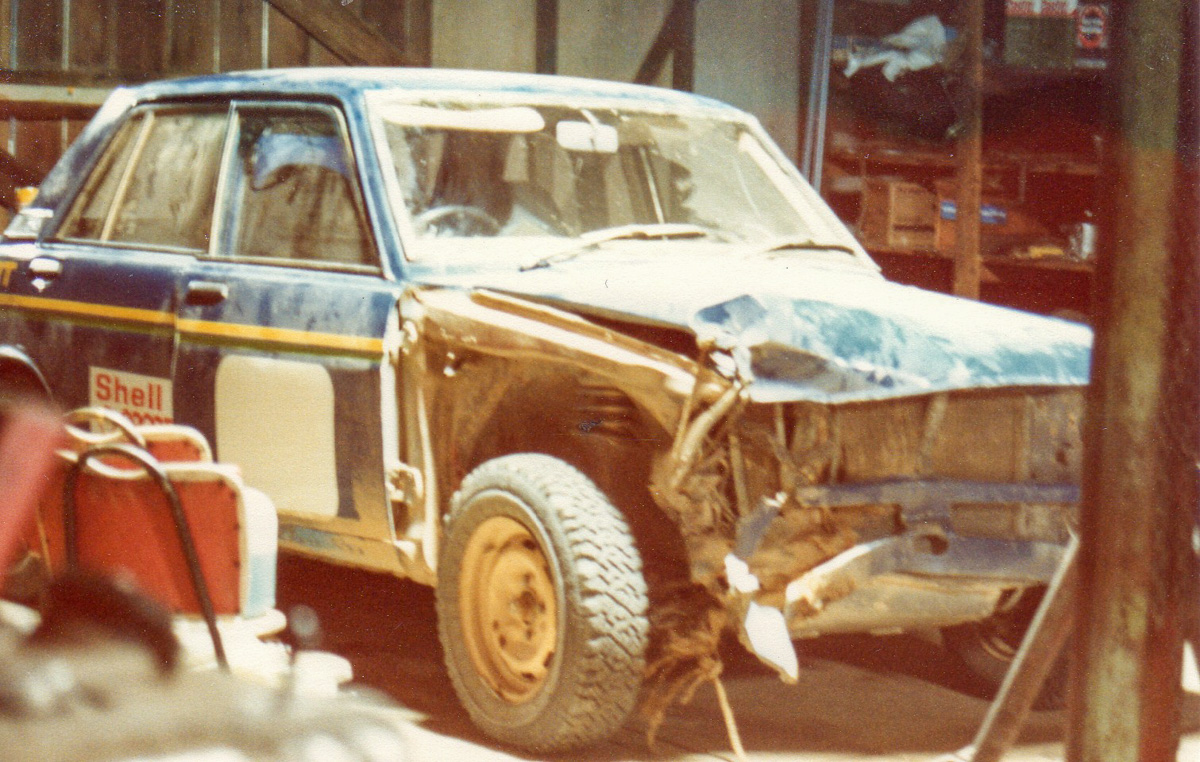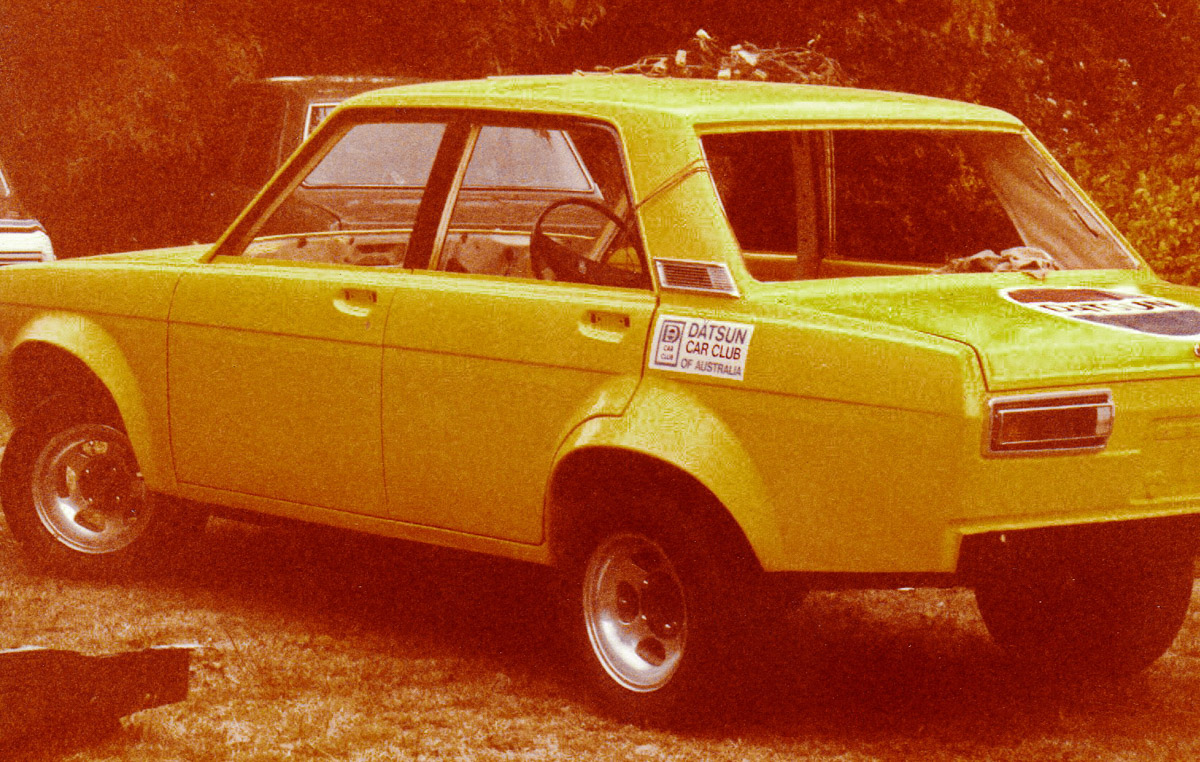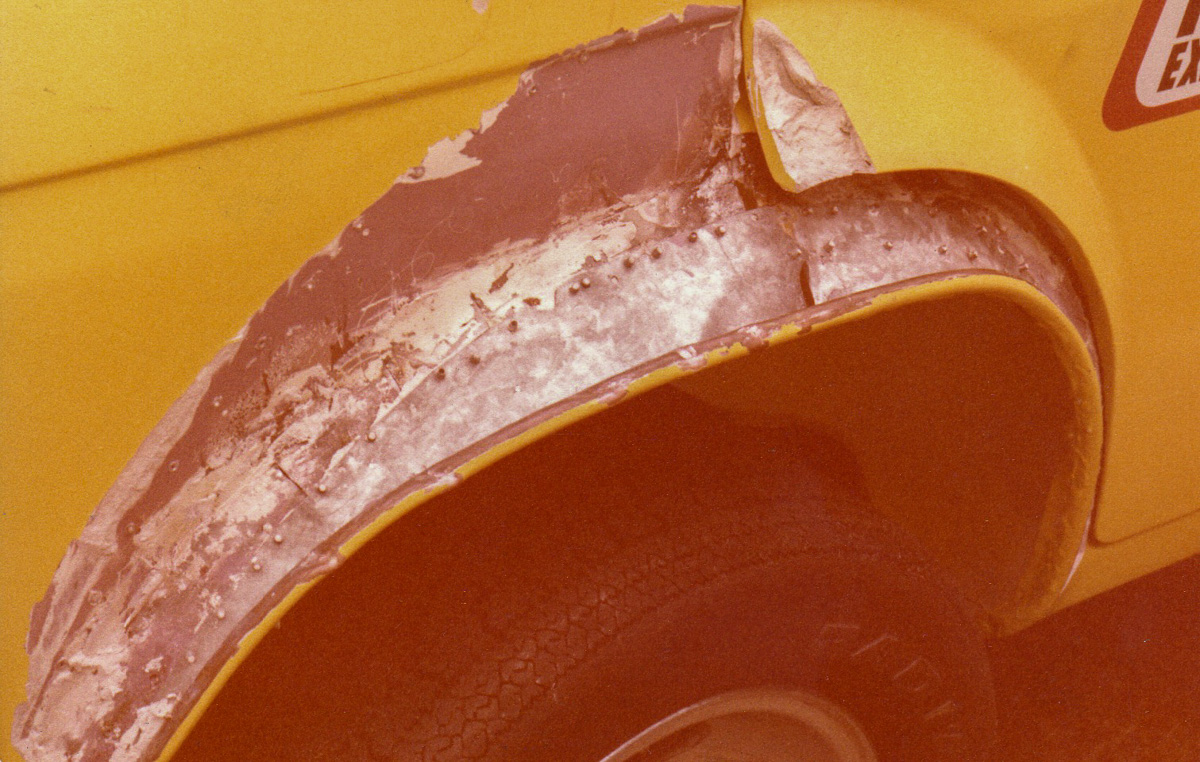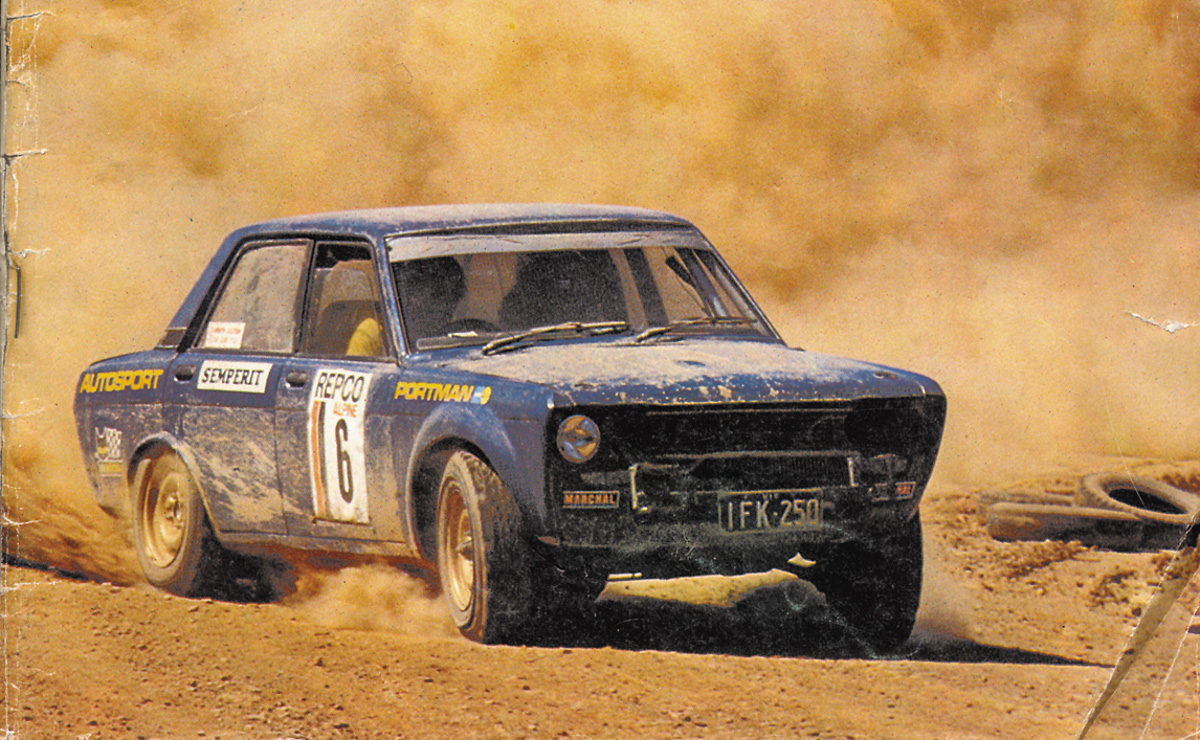
This time the present was in the form of a never before used in competition, Japanese built, FIA big-port headed L20 engine. The holy grail.
Les Collins explains,: “I tell the story of when Howard Marsden arranged the brand new, single cam engine for us to run the (1978) Alpine.
“I had to hire an engine crane from a local Kennards or one of those people at the time and I had a brand new – it was a spare engine for the Southern Cross that year, an L20 which had never been used apart from being dynoed – hanging off an engine crane, on the footpath in Ascot Vale Road, Moonee Ponds, with the sump off it, looking up, thinking ‘Oowwh, that’s all shiny, I wonder what’s in there?’
“That was the level of my skill at the time. I had to take the sump and oil pick up off a 1600 and put it on the new Japanese engine, because the 710 sump would not fit (into a 1600) and it hit the cross member.
“So here was I in the dust and wind and what could be described as a real third world situation (at the back of a flat in Moonee Ponds) and I have this unimaginably valuable engine and I am putting an old 1600 sump on it! I had built a couple of Cooper S engines at that stage, so I knew what they looked like, but they were nothing like a factory Datsun single cam engine.
“I was not a motor mechanic; I was an electrical engineering student. We built that car on the piece of concrete.
“Looking back, I did not know what we were trying to do. All I knew was that we could get this stuff from the works team. I was pretty shy and happy in my own world so the Datsun works stuff was a big step for me. I was a kid in the candy shop. Lollies! Lollies!
“But I did not fully understand what we were doing. I did not understand that we were trying to beat Bondy and Carr to stop Ford from winning the Australian Rally Championship that year. Which is why Howard provided all that assistance. I probably heard those words but they did not sink in as I was too absorbed in my own world, building the car and trying to pass my degree.
“I recall that at the time Gil Davis had a workshop at the rear of his house where he prepared rally cars for customers and for real money, and here was me building a 1600 from a 710 works car on a concrete pad in Moonee Ponds. That was the level of naivety we had in those days. Really, I did not even have a tool box. Really. I was a penniless student and had a few tools, but most of them were for the Cooper S and they were AF size and all these Datsuns were metric!
“Everything in that car was 710; struts, radiator, oil cooler, gearbox, brakes, rear end.”
An historic Alpine Rally win
“We had to flare the guards; paint and sign write it and get it ready – all on a piece of concrete!
“And just so we don’t forget, all that, just because of John Armitage and Howard Marsden!”
Engine spec? 196bhp at 7500rpm and 170 ft lbs at 5000rpm, L20B block, FIA Head. A 50% increase in power!
“We put a rear 710 sway bar on the 1600 and with all the Nissan mechanical stuff fitted Geoff took it for a quick test drive around Moonee Ponds. Mind you it was still multi-coloured at the time as it had not been painted yet after the panel job, thanks to the testing rollover.
“He drove it at full speed in the middle of the day down the bitumen and he turned the steering wheel to take a corner and it just stepped out way too far.
“When we got back to the concrete pad behind the rented flat Geoff said that he thought the 76 degree camshaft was too big, so I went back to Derek Rawson at Nissan and he gave me a 74 degree cam, which was a lot more forgiving to drive with.
“So I diligently changed the camshaft and removed the sway bar – which was going to be bad news if we kept it.
“And then, on the third stage of the Alpine, Geoff said to me: ‘I think we need that bigger cam…’”
The story of that year’s Alpine Rally is full of ups and downs, but needless to say that after a great fight on the Sunday with Colin Bond, Geoff hunted the Escort down and IFK 250 led the field into the final control at the Bright Sportsground. The winner’s champagne had never tasted so good. The celebrations by the crew continued late into the night and probably (no, definitely!) late into the next morning.
Guru Les, however, had other things on his mind. After a very trying and hard working weekend, not to mention several weeks before hand of “710-ising” and then panel beating, he needed to return to Melbourne – on Monday – to face his final year exams at Uni.
Geoff and Ross both said, even 40 plus years after the event, that without doubt the 1978 Alpine win was a defining point in their career and by far the most memorable rally of them all.
You won the Alpine on what??
The Alpine had a lasting effect on Les as well. “He won that Alpine on Semperits – you know what Semperits are? They are the farmer’s winter treads! We won that Alpine on 14 inch 240Z steel wheels and Semperits! There was a stage on Sunday morning near Bright – 11km and a set of tyres!”
The trademark Nissan gold Enkies and new Dunlop SP52s would come later.
As would a new name for IFK 250, “The Grunter.”
Some mechanical soul searching was needed after the big Alpine win, but that had to wait as there was still the final round of the Australian Championship, the Marchal Rallye, to run. The rally, like the Bega Valley Rally, had been postponed due to weather concerns and some organisational problems and it was now to be run on December 16.
Not long after the start, George Fury (now Stanza mounted) lost camshaft drive and it was soon apparent that Carr and his Escort had the edge in performance and he gradually opened a small gap, with Portman never far away. Geoff and Ross fought back gallantly and snuck past Carr into the lead until the second last stage, where Geoff lost time with distributor problems.
Twigger Gale explained: “Geoff needed a rev limiter capability to protect the engine in competition and extend its life.”
After all, it was a pretty special engine, and worth looking after!
In those days, electronic rev limiters had not yet been invented therefore the engine had a mechanical distributor with points.
A ‘works’ distributor used a Bosch rotor button which had a mechanical centrifugal spring operated mechanism which was ‘ground down’ or shortened to fit the distributor and distributor cap used in IFK 250.
Whether the central spring in the top of the distributor cap wasn’t strong enough to keep the button down, or the ribs around the post in the top of the cap had been cut back too much, or the key lug in the rotor button on the distributor shaft was worn or was too short, who knows?
Under centrifugal forces with the high revs the rotor slid up the distributor shaft and spun on the shaft, buggering up the spark timing.
Twigger continued: “This happened on the second last stage (just after dawn) on the Marchal while Geoff was leading and not far from the control, the engine lost timing and wouldn’t run.
“We could hear it coming through the bush then it went quiet, not far away. Then the next car came through. Les found out from them that Geoff was just stopped on the side of the road.
“Geoff, naturally, tried to diagnose the issue on the spot, without luck. However, as the car had stopped so close to the end of the stage, Les ran up the stage from the finish control, found the problem and got IFK going again.”
They finished 18th. Carr won, with Ross Dunkerton (by then in a Stanza) a smidge behind.
Greg Carr won the Australian Rally Championship that year as well.
In Geoff’s world, it was not the best sign-off one can have after a long and hard fought season and it was somewhat of a bitter disappointment following the breakthrough Alpine win, only a few weeks prior.
By the end of 1978, IFK 250, Iteration 2, was in a pretty sad condition. It had largely been a standard body shell without any seam welding or additional strengthening.

The rigours of a few years of really hard rally competition, including the 1977 Castrol rollover, the gruelling Riverland and Readyplan rallies, the blackwood stump in the ’77 Marchal, the testing rollover at Swifts Creek, the fabulous win in the rough and long ’78 Alpine, and the general accumulation of over 30 events worth of fatigue, meant that cracks were becoming evident and, more importantly, very visible.
Body flex was surely significant. Geoff and his faithful crew were convinced a new body was needed and the troops were sent in all directions to find a suitable candidate.
Les again: “So, Geoff won the 1978 Alpine and I moved to Trevaskis Street in South Caulfield. It had a double garage and a big back yard (instead of just a concrete pad without any fences) which was soon filled up with boneyard 1600 bodies.
“Then, at the end of 1978, we all realised that the body of IFK 250 was really buggered.”
End of IFK 250, ‘Iteration 2’.
One of the crew found a yellow 1600 body, which someone had started to build into their idea of a race car. It had huge flared guards and they each had about 15 pounds of panel beater’s bog in them! Les recalls: “The car just seemed to turn up in the backyard – I guess Geoff bought it – and I remember looking at it and wondered if we really had to build a rally car out of this?”
One of the very special modifications which the last iteration of IFK 250 was famous for was the position of the engine. It was moved back significantly in the engine bay.
Legend had it that this was designed to change the car’s balance and to achieve closer to 50/50 front to rear weight distribution, and consequently radically modify and improve the turn in capabilities of a 1600. In an attempt to determine the science and technology behind this feature, Les was asked “When you built the new car, what sort of technology did you apply to determine the position of the engine, which was apparently moved back six inches. Why six inches?”

Six inches is all we need
Les smiled and giggled at the question and responded: “The 1978 car had the inner headlights removed (regulations in Victoria at the time only allowed four forward facing lights, so most 1600s used the original 5¾ inch headlights and fitted a pair of driving lights, and removed the inner pair of headlights) and on the driver’s side the oil cooler lines had to be routed out the front to the really big 710 oil cooler.
“So there was only one place we could fit it and that was in front of the grille. The hole provided by the removed headlight provided an ideal route for the oil cooler, but it looked really ugly!
“It was a Saturday morning and I recall I wanted to make the front of the car look standard, like it should. So I thought I could fit the radiator and the oil cooler behind the standard grille, but the only way I could achieve that was to move the engine back.
“So I looked at it and thought OK, we can do that, and we started with an angle grinder and in five minutes, there it was. There was no masterstroke of determining balance or handling or anything like that.
“It was so I could fit the oil cooler in the engine compartment! God’s honest truth!
“And then we did a few measurements to see where the gearbox cross member would sit, and an hour later it was done. Cut, cut, cut with an angle grinder, then Mig, Mig, Mig with the welder, and all of a sudden the engine was back in and moved back and I had all this room! And it was all because we had an oil cooling problem which needed to be solved.
“The engine and bodywork was the easy part, the real issue was the wipers. We needed to do a bit of work and redesign the wiper linkages to make them work.”
Notwithstanding how badly fatigued the old Grunter body shell was, it didn’t get sent to the wrecker. It was repurposed for a short period (well, maybe not so short) as a 1600 road car with a standard L16 engine for Geoff to drive from Wattle Glen to Melbourne Uni, still in Autosport dark blue, minus the signwriting.
By that time it had received a new nickname – “Gruntless!”.
So, onto to the next season of rallying.
1979 was not the year for the remembering of many good things, particularly in regard to IFK 250. With more DNFs, generally due to mechanical breakage, than ever. The very first event of the year, the Victorian Championship Chrysler Safari, resulted in a DNF, not for mechanical issues, but after hitting a kangaroo and damaging the radiator while leading the event by six minutes.
Redemption was on the cards with a good confidence boosting win in the Begonia Rally – where ace Canberrian co-driver, Wayne Gregson, called the corners as Ross Runnals was on the event’s organising team.
The highlights of the year with IFK 250 (Iteration 3) came down to a third place behind the two Escorts of Greg Carr and Colin Bond in the Castrol International, a second place in the Queensland ARC round, and a well-deserved win (at long last) in the Endrust Rally. IFK’s first Australian Rally Championship win!
But back to the story, which Les continues: “We built a new car – from the yellow car with the big flares, which we got rid of very quickly – and again we painted it Autosport blue.
“It looked really smart. Its first big rally in ‘79 was the Castrol International. I had hand beaten all the front and rear guards and flared them (to fit the Enkie works wheels and the ‘Mickey Mouse’ Dunlop SP52 tyres) and it had all the running gear from the ’78 Alpine car. By that time we also had refitted the 76 degree cam.
“Derek Rawson (the engine specialist at the Nissan factory team in Braeside) had helped us refresh the engine – the good Japanese ’78 Alpine one. On the Wednesday night prior to the Castrol, I was driving the car from Braeside to Caulfield along North Road in peak hour traffic when the oil light came on…”
Photos in this feature have been contributed by: Bruce Keys, Dallas Dogger, John Lemm, Ken Cusack, David Balfour, Ray Berghouse/Chevron Publishing, Peter Whitten, Ian Long, Tom Kaitler, B Team Rally Media.

